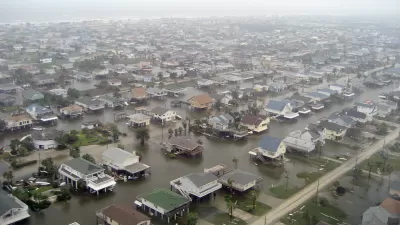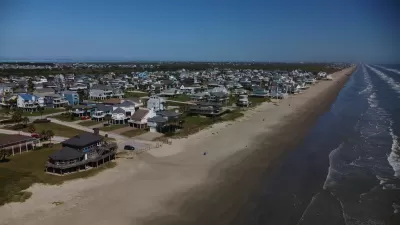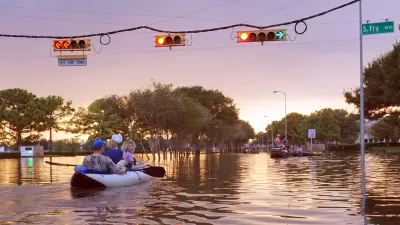Federal legislation and rising sea levels are changing the way homes are insured against flooding. According to this feature article, in fact, flood insurance "is serving as a kind of advance scout into a more difficult future."

Brooke Jarvis writes an in-depth feature article that examines the changing flood insurance industry. The central trope of the article—that flooding risk has already become flooding certainty in some parts of the country—is exemplified by the Hampton Roads Area of Virginia, where the sea level is rising as the land sinks, raising relative sea levels faster than anywhere else on the Atlantic Coast. Jarvis explains of the planning relevance of this story in the city of Norfolk:
The operative measurement for rising waters in Norfolk is not inches but feet — as many as six of them by the end of the century, according to the Army Corps of Engineers, though estimates vary. City planners are forthright that they’re preparing for a future in which parts of the city do not survive.
The extreme risks facing coastal communities are visible in the insurance industry, which is changing quickly in response to the more frequent floods brought about by rising sea levels and more extreme weather events, but also federal legislation known as. Biggert-Waters and Grimm-Waters, passed in 2012 and 2014, respectively. "The first law cut subsidies and phased out grandfathered rates so that premiums would start to reflect the true risk that properties…face — reaching what the N.F.I.P. calls 'actuarial soundness.' The second tried to slow the rate of those increases when it became clear how hard they would hit property owners," writes Jarvis.
The long-read article is the second in a series from the New York Times Magazine's climate issue. The article includes a lot more detail about the insurance industry, the land use implications of sea level rise, and the effect of federal legislation on how homeowners are addressing the challenges of climate change. Consider this article mandatory reading for planners, homeowners, and residents living in coastal areas.
For more coverage of insurance in a world of certain flooding, see a feature article about a Urban Land Institute report from 2013 and an article by ARUP from March 2017.
FULL STORY: When Rising Seas Transform Risk Into Certainty

Planetizen Federal Action Tracker
A weekly monitor of how Trump’s orders and actions are impacting planners and planning in America.

Congressman Proposes Bill to Rename DC Metro “Trump Train”
The Make Autorail Great Again Act would withhold federal funding to the system until the Washington Metropolitan Area Transit Authority (WMATA), rebrands as the Washington Metropolitan Authority for Greater Access (WMAGA).

The Simple Legislative Tool Transforming Vacant Downtowns
In California, Michigan and Georgia, an easy win is bringing dollars — and delight — back to city centers.

The States Losing Rural Delivery Rooms at an Alarming Pace
In some states, as few as 9% of rural hospitals still deliver babies. As a result, rising pre-term births, no adequate pre-term care and "harrowing" close calls are a growing reality.

The Small South Asian Republic Going all in on EVs
Thanks to one simple policy change less than five years ago, 65% of new cars in this Himalayan country are now electric.

DC Backpedals on Bike Lane Protection, Swaps Barriers for Paint
Citing aesthetic concerns, the city is removing the concrete barriers and flexposts that once separated Arizona Avenue cyclists from motor vehicles.
Urban Design for Planners 1: Software Tools
This six-course series explores essential urban design concepts using open source software and equips planners with the tools they need to participate fully in the urban design process.
Planning for Universal Design
Learn the tools for implementing Universal Design in planning regulations.
Smith Gee Studio
City of Charlotte
City of Camden Redevelopment Agency
City of Astoria
Transportation Research & Education Center (TREC) at Portland State University
US High Speed Rail Association
City of Camden Redevelopment Agency
Municipality of Princeton (NJ)





























